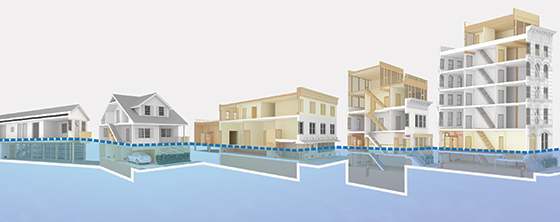The New York City Department of City Planning (DCP) has released "Retrofitting Buildings for Flood Risk," a comprehensive guide for New York City owners of buildings in flood zones.
Part of the city’s response to widespread flooding as a result of Hurricane Sandy, the manual offers retrofitting strategies that will enable home and property owners to reduce the risk of damage and disruption from coastal flooding.
Recent Congressional legislation reforming the National Flood Insurance Program will increase flood insurance premiums for buildings that are not retrofitted, according to a city press release. These increased premiums will directly impact neighborhood stability and housing affordability, especially for working class New Yorkers, the release says.
The manual contains some simple and low-cost actions New Yorkers living in the flood zone can take now to begin to adapt and protect their homes against flooding.
“Incorporating these improvement will help protect our city’s buildings against potential future extreme climatic events,” says Department of Buildings Commissioner Rick D. Chandler. “The Department of Buildings will provide dedicated plan examiners and inspectors to work with and support home and business owners in redesigning their structures to meet the new federally mandated guidelines.”
Related Stories
Codes and Standards | Sep 13, 2019
At least 30 U.S. cities have adopted stricter building energy codes since 2017
Some followed their states in implementing more robust standards.
Codes and Standards | Sep 12, 2019
Illinois law sets maximum retainage on private projects
The change is expected to give contractors bigger checks earlier in project timeline.
Codes and Standards | Sep 10, 2019
Retreat may be the best option for some coastal communities in face of sea level rise
A new study makes the case for relocating in a "strategic, managed" manner.
Codes and Standards | Sep 9, 2019
Free app calculates maximum allowable heights and areas for buildings
A free app that calculates the maximum allowable heights and areas for buildings of various occupancy classifications and types of construction has been released.
Codes and Standards | Sep 6, 2019
Standard for assessing frame deflection using one component polyurethane foams updated
The standard offers guidance when installing fenestration products.
Codes and Standards | Aug 29, 2019
The high cost of gridlock: $166 billion per year
Growing economy means more jobs, more cars, more hours stuck in traffic.
Codes and Standards | Aug 29, 2019
Industry leaders ask for government help as trades shortage worsens
AGC asks for more funding for education and increased immigration to fill gaps.
Codes and Standards | Aug 29, 2019
Code-conforming wood design guide available
The guide summarizes provisions for the use of wood and wood products in the 2018 IBC.
Codes and Standards | Aug 29, 2019
LEED residential market up 19% since 2017
The U.S. Green Building Council says that the LEED residential market has grown 19% since 2017. Nearly 500,000 single family, multifamily, and affordable housing units have been certified globally.
Codes and Standards | Aug 27, 2019
Slower speed limits in urban areas offer multiple benefits
Improved safety, better adoption of electric scooters and autonomous vehicles are possible if drivers ease off the accelerator.

















